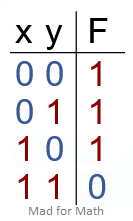NAND GATE LEARNING TOOL
Click on an input or a row on the truth table to change the input values.
F = (x . y)'
= x' + y'
=
=
=
INFORMATION
A NAND gate performs the logical complement of an AND gate. If the inputs are denoted as x and y, the output of a NAND gate is (x . y)'. According to the De Morgan's Law, the expression (x . y)' can be written as x' + y'.
For a NAND gate, when all inputs are logic-1, the output is logic-0. In all other cases, the output is logic-1.
The truth table for a two-input NAND gate is as follows:

In this table, x and y represent the inputs and F represents the output. Each row in the table indicates the corresponding output value based on the values of inputs in that row. For example, the first row indicates that F = 1 for x = 0 and y = 0.
In logic, the NAND operation is represented by the "⊼" or "↑" symbol.
WHAT IS NAND GATE LEARNING TOOL?
NAND gate learning tool,
- Allows the user to select the input values for a 2-input, 3-input or 4-input NAND gate,
- Illustrates the output on the circuit symbol and the truth table.
HOW TO USE THE NAND GATE LEARNING TOOL?
You can select the input values yourself or set them randomly.
USER INPUTS

To toggle the input values between 1 and 0, click on the inputs.

Or click on any row on the truth table to set the input values.

ALL = 0 and ALL = 1 buttons reset and set all input values, respectively.
RANDOM INPUTS

The DIE ICON generates a random set of values for the inputs.
SELECTING THE NUMBER OF INPUTS

2, 3, and 4 input NAND gates are available.
DOWNLOADING THE SOLUTION

You can download the solution as an image file with .jpg extension if you click on the "Download Solution" link at the bottom of the solution panel. You can share the downloaded image file.
